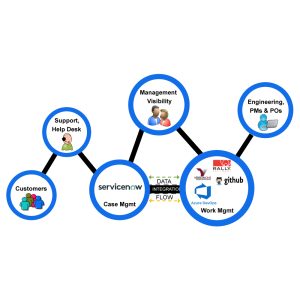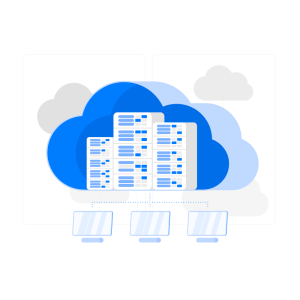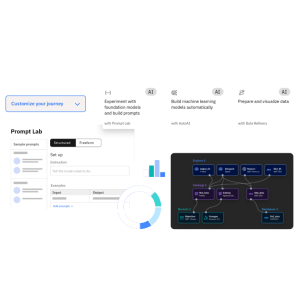The automation revolution is no longer on the horizon—it’s already reshaping the way businesses operate. Enterprises today are confronted with the dual challenge of streamlining operations while meeting fast-changing customer expectations in a highly competitive and uncertain global environment. Traditional automation, which focused largely on rule-based repetitive tasks, is proving inadequate in addressing the complexity, speed, and data intensity of modern business processes.
This is where intelligent automation enters the picture. It combines the power of artificial intelligence (AI), machine learning, natural language processing (NLP), robotic process automation (RPA), and advanced analytics to go beyond mere task automation. It enables systems to learn from data, adapt to changing conditions, and make decisions with minimal human intervention—significantly accelerating digital transformation.
At the center of this evolution is IBM Cloud Pak for Business Automation (IBM CP4BA). Built on Red Hat OpenShift, this modular, containerized platform is designed to help organizations automate everything from data capture and document handling to decision workflows and customer service interactions. IBM CP4BA doesn’t just automate tasks; it transforms entire business functions by introducing intelligence, agility, and resilience at scale.
Whether you’re automating invoice approvals, streamlining regulatory workflows, or digitizing a multi-stage onboarding process, CP4BA provides the building blocks for long-term transformation. With its ability to integrate seamlessly with legacy systems and modern cloud environments, it’s tailored for enterprises looking to modernize without disruption.
In this guide, we’ll walk through every critical step of implementing intelligent automation using IBM CP4BA—covering core features, deployment strategies, use cases across industries, and best practices based on real-world implementations led by Nexright, a certified IBM Solution Partner. This isn’t just a technology overview—it’s a practical playbook for building the intelligent enterprise.
1. What Is IBM Cloud Pak for Business Automation?
IBM Cloud Pak for Business Automation (CP4BA) is a powerful, enterprise-grade platform designed to help organizations automate business operations intelligently and efficiently. It combines AI, machine learning, workflow orchestration, robotic process automation (RPA), and decision management into one unified solution—all running on Red Hat OpenShift for containerization and hybrid cloud flexibility. This architecture allows companies to modernize their operations without rebuilding their existing systems from scratch.
What sets IBM CP4BA apart is its modular design, enabling businesses to implement only the components they need and expand over time. Whether the goal is to eliminate paper-heavy tasks, accelerate approvals, integrate siloed systems, or reduce manual errors, CP4BA delivers a comprehensive set of tools to achieve enterprise-wide automation. It supports integration with legacy software, ERPs, CRMs, and databases, while maintaining security and compliance standards critical in regulated industries.
The platform is not just about automating tasks—it’s about rethinking how work is done. It empowers teams to make faster, data-driven decisions, improve compliance through automated governance, and deliver seamless customer experiences. From front-office workflows like customer onboarding to back-office functions like invoice processing, CP4BA drives consistency, accuracy, and agility across every business layer.
Key Capabilities Include:
- Workflow Automation
Design, model, and deploy end-to-end business workflows across departments using a visual, low-code interface. CP4BA enables business users to collaborate with IT, create rule-based automations, and rapidly adjust workflows in response to business changes—all while integrating with existing enterprise systems. - Decision Automation
CP4BA helps automate complex decision-making by integrating business rules with AI models. Enterprises can use this to manage dynamic decisions across industries—such as credit risk approvals, policy compliance checks, or personalized marketing actions—at scale and with traceability. - Document Processing
Intelligent document processing capabilities allow organizations to extract, classify, and interpret data from structured and unstructured documents. This is particularly useful in areas like legal, finance, and healthcare where large volumes of PDFs, forms, and contracts need to be digitized and analyzed automatically. - Content Services
Manage enterprise content securely throughout its lifecycle. With version control, access permissions, and compliance-friendly document handling, teams can collaborate more effectively and ensure content is traceable, searchable, and regulatory-ready. - Robotic Process Automation (RPA)
RPA bots within CP4BA are designed to mimic human interactions with digital systems, automating repetitive and rule-based tasks like data entry, invoice reconciliation, and customer data validation. These bots reduce error rates, enhance speed, and free up employees to focus on value-added tasks. - Process Mining & Analytics
CP4BA includes real-time process mining tools that analyze digital footprints to discover how processes are actually executed. These insights help identify inefficiencies, bottlenecks, and improvement areas, enabling organizations to optimize workflows continuously.
2. Why Intelligent Automation Is Crucial Today
In today’s fast-changing digital economy, businesses are expected to deliver faster, more personalized services, operate with greater efficiency, and respond to disruptions with agility. Traditional process automation—while effective at removing repetitive tasks—falls short in dynamic environments that demand real-time intelligence and contextual decision-making. That’s where intelligent automation comes in.
Unlike conventional RPA that simply mimics human actions, intelligent automation integrates artificial intelligence, machine learning, and data analytics to simulate human judgment and continuously optimize outcomes. This allows enterprises to automate not only how work gets done—but how decisions are made across the value chain. Intelligent automation becomes a strategic enabler, helping organizations remain competitive, compliant, and customer-centric in an increasingly volatile market.
With IBM Cloud Pak for Business Automation (CP4BA), companies can deploy intelligent automation at scale—bringing together workflow orchestration, decision logic, content services, RPA, and AI into a unified, adaptable ecosystem. Below are some of the key reasons why investing in intelligent automation is no longer optional but essential:
- Enhance Operational Agility – Organizations must adapt quickly to changing customer needs, regulatory shifts, and market disruptions. CP4BA enables enterprises to automate entire workflows—from document processing to complex decision trees—so teams can pivot and reconfigure operations in real time without starting from scratch. This flexibility is critical for navigating uncertainty, seizing new opportunities, and maintaining competitive speed.
- Improve Customer Experience – Customers today expect instant gratification and personalized interactions. Intelligent automation helps deliver that by integrating chatbots, AI-powered decision engines, and automated approvals that respond in real time. For example, a loan application or insurance claim can be processed within minutes rather than days, improving satisfaction and retention across digital touchpoints.
- Ensure Regulatory Compliance – Industries like finance, healthcare, and manufacturing face increasingly strict compliance obligations. Intelligent automation ensures that every process step—from approvals to document storage—is tracked, logged, and auditable. CP4BA provides built-in governance, role-based access, and policy enforcement mechanisms, helping organizations maintain compliance while reducing human error and audit risks.
- Boost Workforce Productivity – By automating repetitive, rules-based tasks, employees can focus on higher-value activities such as strategy, innovation, and customer relationship building. CP4BA integrates AI and decision automation to intelligently delegate work between bots and humans, increasing throughput without increasing headcount. This improves employee satisfaction while reducing process bottlenecks.
- Accelerate Digital Transformation – Intelligent automation acts as a foundation for digital transformation by connecting siloed systems, streamlining data flows, and enabling real-time visibility into operations. IBM CP4BA’s modular architecture means businesses can start with one process and scale across departments, modernizing legacy operations step by step without business disruption.
Ultimately, intelligent automation with IBM CP4BA transforms businesses from reactive to proactive. Instead of simply doing things faster, enterprises start doing things smarter—making better decisions, reducing costs, enhancing service delivery, and building a resilient foundation for future innovation. Nexright helps organizations not only deploy CP4BA effectively, but also reimagine their business processes for long-term strategic advantage.
3. Step-by-Step Implementation with IBM CP4BA
Implementing intelligent automation successfully requires more than just deploying tools—it demands a strategic, phased approach that balances technology with business needs. IBM Cloud Pak for Business Automation (CP4BA) provides the flexibility and scalability to meet these demands. Here’s a comprehensive breakdown of each phase:
Step 1: Define Goals and Use Cases
Start by aligning your automation initiative with core business goals. Are you aiming to reduce operational costs, improve customer response time, increase compliance, or scale workflows across departments? Conduct cross-functional discovery sessions to uncover inefficiencies—such as high-volume approval processes, manual data entry, or delayed document handling.
Nexright recommends building a use case matrix that maps each pain point to an estimated ROI, ease of implementation, and strategic alignment. For example, automating invoice approvals might yield high impact with low complexity, making it an ideal starting point. This prioritization helps focus resources and secure stakeholder buy-in early in the journey.
Step 2: Design the Automation Blueprint
Once goals are set, design a blueprint that integrates people, processes, and technology. This should include current-state process maps, bottleneck identification, integration points, and security requirements. Engage IT architects, business analysts, and compliance leads to define success metrics and ensure stakeholder alignment.
Choose your automation entry point—this could be workflow orchestration, document ingestion, decision rules, or RPA. Create a roadmap that includes phased module rollouts, with clear deliverables and feedback loops. Think of this blueprint as the foundation of your automation journey.
Step 3: Choose the Right CP4BA Modules
IBM CP4BA is modular by design, allowing organizations to pick and deploy capabilities based on their needs. Here are the key modules:
- Automation Workstream Services: For designing workflows across departments using low-code/no-code tools.
- Operational Decision Manager (ODM): Ideal for automating decisions using business rules and AI.
- Automation Document Processing: Used to extract and classify data from unstructured content like PDFs and invoices.
- Content Services: Securely manage enterprise content with access control, versioning, and audit trails.
- Robotic Process Automation (RPA): Deploy bots to automate repetitive, rule-based digital tasks.
- Business Automation Insights (BAI): Visualize operational data with dashboards and analytics to optimize performance.
Each module integrates seamlessly with the others, allowing you to expand your automation ecosystem gradually while maintaining agility and control.
Step 4: Deploy on Cloud or Hybrid Environment
One of IBM CP4BA’s biggest advantages is its deployment flexibility. Built on Red Hat OpenShift, it supports containerized deployment across public, private, or hybrid cloud environments. This means enterprises can modernize without being locked into a single infrastructure.
You can choose to deploy on IBM Cloud, on-premises servers, or a hybrid architecture that integrates with your existing infrastructure. This model ensures security, resilience, and scalability—all while maintaining centralized control over your automation assets.
Step 5: Integrate AI and Watson
This is where traditional automation evolves into intelligent automation. IBM Watson services can be seamlessly integrated into your workflows to enhance decision-making, extract meaning from unstructured data, and personalize interactions at scale.
For instance, Watson NLP can interpret customer queries in real time, while Watson Discovery can scan and summarize documents to support decision engines. Fraud detection, sentiment analysis, and predictive modeling are also enabled through Watson’s suite of cognitive APIs. Nexright helps businesses integrate these AI capabilities to unlock maximum value from automation.
Step 6: Launch, Monitor, and Optimize
Once your automation components are live, shift focus to performance monitoring and continuous improvement. Use Business Automation Insights (BAI) to track key workflow metrics like processing time, exception rates, and decision accuracy. BAI provides event-driven dashboards and real-time alerts that surface inefficiencies early.
In parallel, apply process mining tools to analyze event logs, identify bottlenecks, and recommend changes. Nexright encourages clients to adopt a sprint-based enhancement model—running optimization loops every quarter based on stakeholder feedback and BAI insights.
Also, integrate A/B testing into your decision models to fine-tune rules and improve automated outcomes over time.
4. Common Enterprise Use Cases
IBM CP4BA enables transformation across a wide range of industries by automating critical workflows and reducing manual effort. Here are some of the most impactful use cases:
- Banking: Automate end-to-end loan origination, manage compliance-heavy documentation, and accelerate customer onboarding using decision services, RPA bots, and secure content workflows.
- Insurance: Streamline claims processing, automate fraud detection, and reduce turnaround time on policy underwriting with intelligent document classification and decision automation.
- Healthcare: Integrate patient data across systems, automate billing and coding cycles, and enhance regulatory compliance through AI-driven workflows and audit-ready documentation.
- Retail: Improve inventory visibility, speed up order fulfillment, and automate vendor onboarding by combining workflow orchestration with business rules and document automation.
- Manufacturing: Digitize work order approvals, automate quality control audits, and track maintenance schedules using robotic automation and real-time process insights.
5. Real Business Value from IBM CP4BA
Organizations implementing CP4BA with Nexright have realized the following tangible outcomes:
- 40–60% time reduction in document-intensive workflows by automating data capture, routing, and validation—freeing up employees for higher-value tasks.
- 99% accuracy in automated decision-making, using AI-trained models and business rules that ensure consistent, compliant outcomes with minimal errors.
- 50% cost savings on manual processing within 6–12 months of deployment, as automation reduces labor costs and streamlines multi-step operations.
- Improved SLA adherence across customer service operations by accelerating request handling, minimizing delays, and optimizing queue management.
- Faster ROI through incremental module deployment, enabling phased rollouts that deliver measurable value without disrupting ongoing business operations.
These benefits stem from IBM’s AI-first design philosophy and Nexright’s structured implementation approach.
6. Best Practices for Successful Deployment
- Start with a pilot: Choose one high-value workflow to test automation in a controlled environment. This allows your team to validate the business case, uncover integration issues, and build internal confidence.
- Focus on quick wins: Target processes that are well-defined, repetitive, and rules-driven. These early wins help demonstrate ROI and generate momentum for wider adoption across departments.
- Adopt agile delivery: Roll out automation in short sprints with iterative improvements. Agile cycles allow faster testing, better stakeholder feedback, and continuous refinement of workflows.
- Engage business users: Equip non-technical teams with low-code tools and hands-on training. Involving them early ensures better adoption, more accurate workflows, and a higher success rate.
- Measure continuously: Track automation KPIs such as cycle time, exception rates, and accuracy. Leverage dashboards and AI analytics to guide optimization and prove impact.
- Maintain security governance: Apply strict role-based access, audit trails, and data encryption. Ensure all automation systems comply with industry standards and internal security policies.
7. Nexright’s Role in IBM CP4BA Implementation
As a certified IBM Solution Partner, Nexright brings strategic insight, technical depth, and hands-on experience to help enterprises unlock the full potential of intelligent automation. Our support spans every stage of your automation journey:
- Automation Readiness Assessment
We analyze your current processes, data flows, and workforce readiness to pinpoint automation opportunities. This includes maturity scoring, ROI potential, and infrastructure compatibility checks to ensure a smooth transformation. - Architecture & Design
Nexright defines a scalable architecture tailored to your enterprise goals, including hybrid cloud deployment options. We map automation workflows, integration touchpoints, and decision models aligned with key performance indicators. - CP4BA Module Deployment
Our team handles seamless deployment of individual or bundled modules such as Workflow, RPA, ODM, or Document Processing. We configure, test, and integrate them into your IT environment without disrupting business continuity. - AI & Decision Integration
We embed IBM Watson tools for natural language processing, predictive analytics, and cognitive decision support. This creates smarter, data-driven automation that adapts in real time to customer behavior and operational data. - Training & Change Management
Nexright offers structured onboarding, hands-on workshops, and user certification to upskill internal teams. We also implement change management programs to foster adoption and build a culture of innovation. - Managed Support & Optimization
Post-deployment, we offer continuous monitoring, performance tuning, and issue resolution. Our managed services ensure your automation environment evolves with business needs and stays optimized for peak performance.
With Nexright’s expertise, organizations can avoid common pitfalls, reduce time-to-value, and scale automation confidently.
8. Scaling Intelligent Automation Across the Enterprise
After initial success, intelligent automation must scale organization-wide to drive deeper efficiency and agility. IBM CP4BA supports enterprise-wide expansion with the following features:
- Scalable Microservices Architecture
The platform’s modular, containerized design allows you to add or update workflows, decision services, and automation components independently—without disrupting existing operations or requiring full redeployments. - Enterprise Content Management
Manage structured and unstructured data securely across departments and geographies. Built-in access control, metadata tagging, and retention policies ensure compliant content management across the enterprise. - Unified Insights Dashboard
Monitor real-time KPIs across all automation initiatives using centralized dashboards. These analytics provide visibility into workflow efficiency, exception handling, and user performance at scale. - Workflow Governance Controls
Apply centralized governance over process changes, version control, and audit logs. CP4BA helps maintain regulatory compliance, enforce business policies, and standardize automation practices across teams.
This makes CP4BA not just a solution—but a long-term automation platform.
Accelerate Enterprise Transformation with Intelligent Automation
Intelligent automation isn’t just a technology trend—it’s a foundational shift in how modern enterprises operate, compete, and innovate. As customer expectations evolve and business environments grow more complex, companies must move beyond fragmented tools and legacy systems. They need an integrated, scalable, and intelligent approach to automating work—and that’s exactly what IBM Cloud Pak for Business Automation (CP4BA) delivers.
IBM CP4BA empowers organizations to automate processes end-to-end—from document ingestion and decision-making to content management and robotic process execution. Its modular architecture ensures that businesses can start small with a single workflow and expand confidently as value becomes evident. The integration of AI, business rules, analytics, and process mining ensures not just automation—but optimization. Enterprises are not just doing things faster—they’re doing them smarter.
But successful transformation demands more than software. It requires strategic alignment, thoughtful design, seamless implementation, and ongoing optimization. That’s where Nexright adds unmatched value. As a certified IBM Solution Partner, we’ve guided digital leaders across sectors—from finance and insurance to healthcare and manufacturing—through the full lifecycle of intelligent automation. Our frameworks help enterprises assess readiness, design high-impact solutions, and evolve with agility. From pilots to enterprise-wide rollouts, Nexright ensures that your investment in IBM CP4BA delivers lasting impact.
Now is the time to move forward. Begin by automating a single high-friction process—like customer onboarding or claims approval—and let the results speak for themselves. With Nexright, you’re not just implementing automation. You’re building a smarter, more resilient enterprise, ready to lead in the age of intelligence.




